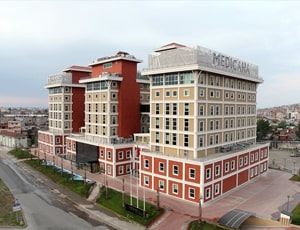Surgically replacing a worn-out or injured hip joint with a new one (hip prosthesis) is known as complete hip replacement surgery, sometimes referred to as total hip arthroplasty. These prostheses are composed of ceramic, metal, or durable, strong plastic. The hip joint may be compromised as a result of wear and tear that has occurred gradually over time, arthritis, fractures, injuries, or chronic illnesses.
The femur, the head of the thigh bone, is the ball that fits into the pelvic bone's socket, resembling a ball and socket of the hip. A prosthesis is used to replace the hip joint's ball and socket during a total hip replacement procedure.
| Country | Cost | Local_currency |
|---|---|---|
| United Kingdom | USD 14170 - 16340 | 11194 - 12909 |
| Turkey | USD 6499 - 18210 | 195880 - 548849 |
| Spain | USD 30210 - 33700 | 27793 - 31004 |
| United States | USD 13660 - 40400 | 13660 - 40400 |
| Singapore | USD 31000 | 41540 |
Treatment cost

We provide numerous services for your medical journey, including:
With us, you are sure to receive all the benefits at competitive prices which is a better choice than paying actual hospital costs. As the name suggests, Unilateral Total Hip Replacement represents a procedure which replaces the ailing bone and cartilage of one hip joint with artificial material. This is done after general anesthesia has been given to the person undergoing the replacement procedure. The material used for implants is made of either plastic, metal or ceramic and it restores the function as well as alignment of the hip., MediGence brings to you the best possible offers in packages with Fortis Hospital, Shalimar Bagh in India.

MediGence is offering immense facilities for your medical journey such as:
We offer packages at reasonable pricing that include a variety of additional advantages, making it a better deal than paying for individual perks at the hospital. As the name suggests, Unilateral Total Hip Replacement represents a procedure which replaces the ailing bone and cartilage of one hip joint with artificial material. This is done after general anesthesia has been given to the person undergoing the replacement procedure. The material used for implants is made of either plastic, metal or ceramic and it restores the function as well as alignment of the hip., MediGence brings to you the best possible offers in packages with NMC Royal Hospital, DIP in United Arab Emirates.

Parkway East Hospital located in Joo Chiat Pl, Singapore is accredited by JCI. Also listed below are some of the most prominent infrastructural details:

Types of Total Hip Replacement U/L in Medanta - The Medicity and its associated cost
| Treatment Option | Approximate Cost Range (USD) | Approximate Cost Range (INR) |
|---|---|---|
| U/L Total Hip Replacement | 6300 - 8935 | 513050 - 740551 |
| Cemented Hip Replacement | 4525 - 6826 | 361561 - 557637 |
| Uncemented Hip Replacement | 6104 - 7908 | 506840 - 636191 |
| Hybrid Hip Replacement | 5022 - 7226 | 409294 - 609391 |
| Minimally Invasive Hip Replacement | 7235 - 8960 | 599677 - 734488 |
| Robotic-Assisted Hip Replacement | 8360 - 9921 | 693236 - 828046 |
| Revision Hip Replacement | 8981 - 11321 | 733675 - 940325 |
DOCTORS IN 14 SPECIALITIES
FACILITIES & AMENITIES

Types of Total Hip Replacement U/L in Artemis Health Institute and its associated cost
| Treatment Option | Approximate Cost Range (USD) | Approximate Cost Range (INR) |
|---|---|---|
| U/L Total Hip Replacement | 6105 - 9030 | 513754 - 727182 |
| Cemented Hip Replacement | 4520 - 6625 | 370810 - 563103 |
| Uncemented Hip Replacement | 6284 - 7762 | 497209 - 646591 |
| Hybrid Hip Replacement | 4974 - 7167 | 414714 - 611575 |
| Minimally Invasive Hip Replacement | 7174 - 9033 | 605204 - 733800 |
| Robotic-Assisted Hip Replacement | 8440 - 9974 | 698963 - 813086 |
| Revision Hip Replacement | 9033 - 11150 | 726592 - 934645 |
DOCTORS IN 15 SPECIALITIES
FACILITIES & AMENITIES


Types of Total Hip Replacement U/L in Apollo Hospitals and its associated cost
| Treatment Option | Approximate Cost Range (USD) | Approximate Cost Range (INR) |
|---|---|---|
| U/L Total Hip Replacement | 6301 - 8895 | 514149 - 722321 |
| Cemented Hip Replacement | 4600 - 6881 | 364098 - 552834 |
| Uncemented Hip Replacement | 6199 - 7812 | 502300 - 637059 |
| Hybrid Hip Replacement | 5161 - 7221 | 406744 - 594740 |
| Minimally Invasive Hip Replacement | 7353 - 9035 | 605547 - 749962 |
| Robotic-Assisted Hip Replacement | 8406 - 10276 | 694206 - 816426 |
| Revision Hip Replacement | 8954 - 11317 | 734276 - 931601 |
DOCTORS IN 14 SPECIALITIES
FACILITIES & AMENITIES

Types of Total Hip Replacement U/L in Venkateshwar Hospital and its associated cost
| Treatment Option | Approximate Cost Range (USD) | Approximate Cost Range (INR) |
|---|---|---|
| U/L Total Hip Replacement | 5573 - 8099 | 459307 - 662614 |
| Cemented Hip Replacement | 4049 - 6075 | 332451 - 499600 |
| Uncemented Hip Replacement | 5556 - 7077 | 459560 - 582883 |
| Hybrid Hip Replacement | 4585 - 6594 | 375780 - 539404 |
| Minimally Invasive Hip Replacement | 6625 - 8106 | 543083 - 667984 |
| Robotic-Assisted Hip Replacement | 7578 - 9169 | 621468 - 750379 |
| Revision Hip Replacement | 8126 - 10106 | 669025 - 830338 |
DOCTORS IN 13 SPECIALITIES
FACILITIES & AMENITIES

Types of Total Hip Replacement U/L in Global Health City and its associated cost
| Treatment Option | Approximate Cost Range (USD) | Approximate Cost Range (INR) |
|---|---|---|
| U/L Total Hip Replacement | 6086 - 8879 | 497679 - 736911 |
| Cemented Hip Replacement | 4568 - 6768 | 368556 - 547411 |
| Uncemented Hip Replacement | 6206 - 7922 | 507987 - 644270 |
| Hybrid Hip Replacement | 4955 - 7405 | 422420 - 611708 |
| Minimally Invasive Hip Replacement | 7260 - 9122 | 606126 - 745096 |
| Robotic-Assisted Hip Replacement | 8300 - 10117 | 699417 - 814785 |
| Revision Hip Replacement | 9099 - 11342 | 729432 - 934333 |

Types of Total Hip Replacement U/L in Primus Super Speciality Hospital and its associated cost
| Treatment Option | Approximate Cost Range (USD) | Approximate Cost Range (INR) |
|---|---|---|
| U/L Total Hip Replacement | 5575 - 8113 | 456142 - 666032 |
| Cemented Hip Replacement | 4053 - 6063 | 331633 - 498746 |
| Uncemented Hip Replacement | 5580 - 7115 | 457642 - 581840 |
| Hybrid Hip Replacement | 4550 - 6596 | 372867 - 540525 |
| Minimally Invasive Hip Replacement | 6574 - 8102 | 543096 - 663399 |
| Robotic-Assisted Hip Replacement | 7612 - 9098 | 625761 - 748593 |
| Revision Hip Replacement | 8126 - 10146 | 666891 - 834238 |

Types of Total Hip Replacement U/L in Fortis Malar Hospital and its associated cost
| Treatment Option | Approximate Cost Range (USD) | Approximate Cost Range (INR) |
|---|---|---|
| U/L Total Hip Replacement | 5582 - 8116 | 457000 - 668604 |
| Cemented Hip Replacement | 4056 - 6099 | 332883 - 501324 |
| Uncemented Hip Replacement | 5576 - 7123 | 456537 - 584966 |
| Hybrid Hip Replacement | 4576 - 6611 | 373271 - 539736 |
| Minimally Invasive Hip Replacement | 6595 - 8110 | 539215 - 664141 |
| Robotic-Assisted Hip Replacement | 7636 - 9166 | 625525 - 752111 |
| Revision Hip Replacement | 8101 - 10191 | 666392 - 829788 |
DOCTORS IN 9 SPECIALITIES
FACILITIES & AMENITIES

Gleneagles Hospital located in Napier Road, Singapore is accredited by JCI. Also listed below are some of the most prominent infrastructural details:

Mount Elizabeth Hospital located in Singapore, Singapore is accredited by JCI. Also listed below are some of the most prominent infrastructural details:

Types of Total Hip Replacement U/L in Sterling Wockhardt Hospital and its associated cost
| Treatment Option | Approximate Cost Range (USD) | Approximate Cost Range (INR) |
|---|---|---|
| U/L Total Hip Replacement | 5596 - 8094 | 456275 - 665351 |
| Cemented Hip Replacement | 4059 - 6062 | 333718 - 497974 |
| Uncemented Hip Replacement | 5571 - 7117 | 456235 - 582893 |
| Hybrid Hip Replacement | 4562 - 6589 | 375697 - 538959 |
| Minimally Invasive Hip Replacement | 6603 - 8145 | 540945 - 667873 |
| Robotic-Assisted Hip Replacement | 7607 - 9126 | 621565 - 749053 |
| Revision Hip Replacement | 8146 - 10189 | 666006 - 829889 |

Types of Total Hip Replacement U/L in Star Hospitals and its associated cost
| Treatment Option | Approximate Cost Range (USD) | Approximate Cost Range (INR) |
|---|---|---|
| U/L Total Hip Replacement | 5170 - 7537 | 417543 - 608671 |
| Cemented Hip Replacement | 3758 - 5633 | 306610 - 454026 |
| Uncemented Hip Replacement | 5145 - 6501 | 425011 - 545215 |
| Hybrid Hip Replacement | 4225 - 6110 | 341254 - 500835 |
| Minimally Invasive Hip Replacement | 5999 - 7586 | 493769 - 622557 |
| Robotic-Assisted Hip Replacement | 6923 - 8530 | 577364 - 697679 |
| Revision Hip Replacement | 7436 - 9288 | 617371 - 774094 |

Types of Total Hip Replacement U/L in Medicana International Istanbul and its associated cost
| Treatment Option | Approximate Cost Range (USD) | Approximate Cost Range (TRY) |
|---|---|---|
| U/L Total Hip Replacement | 8324 - 11273 | 255342 - 345596 |
| Cemented Hip Replacement | 5588 - 8035 | 167080 - 235011 |
| Uncemented Hip Replacement | 6826 - 9065 | 207876 - 276924 |
| Hybrid Hip Replacement | 6106 - 8355 | 186031 - 258475 |
| Minimally Invasive Hip Replacement | 7789 - 10038 | 233583 - 306613 |
| Robotic-Assisted Hip Replacement | 9093 - 11262 | 273297 - 335642 |
| Revision Hip Replacement | 10166 - 13512 | 299912 - 401225 |
DOCTORS IN 10 SPECIALITIES
FACILITIES & AMENITIES

Types of Total Hip Replacement U/L in Memorial Antalya Hospital and its associated cost
| Treatment Option | Approximate Cost Range (USD) | Approximate Cost Range (TRY) |
|---|---|---|
| U/L Total Hip Replacement | 8475 - 11416 | 251756 - 333148 |
| Cemented Hip Replacement | 5730 - 7772 | 171488 - 242192 |
| Uncemented Hip Replacement | 6737 - 8877 | 202964 - 267007 |
| Hybrid Hip Replacement | 6131 - 8303 | 189552 - 256356 |
| Minimally Invasive Hip Replacement | 7994 - 10326 | 237283 - 304721 |
| Robotic-Assisted Hip Replacement | 8903 - 11460 | 269664 - 340889 |
| Revision Hip Replacement | 10081 - 13608 | 309374 - 414450 |
DOCTORS IN 11 SPECIALITIES
FACILITIES & AMENITIES

Types of Total Hip Replacement U/L in Medicana International Samsun Hospital and its associated cost
| Treatment Option | Approximate Cost Range (USD) | Approximate Cost Range (TRY) |
|---|---|---|
| U/L Total Hip Replacement | 8281 - 11471 | 258712 - 346499 |
| Cemented Hip Replacement | 5702 - 7761 | 167385 - 234738 |
| Uncemented Hip Replacement | 6826 - 9054 | 201128 - 268963 |
| Hybrid Hip Replacement | 6154 - 8466 | 187905 - 255601 |
| Minimally Invasive Hip Replacement | 8045 - 10248 | 241516 - 299236 |
| Robotic-Assisted Hip Replacement | 8934 - 11328 | 272205 - 342438 |
| Revision Hip Replacement | 10282 - 13318 | 311424 - 404097 |
DOCTORS IN 11 SPECIALITIES
FACILITIES & AMENITIES
Unilateral total knee replacement (TKR), or unilateral total knee arthroplasty (TKA), is a surgical procedure to replace a damaged or worn-out knee joint with an artificial joint, or prosthesis, in only one knee. Here's an overview of this procedure: the unilateral (U/L) total hip replacement:
Classification:
Unilateral total hip replacement refers to the replacement of only one hip joint. It can be classified based on various factors:
The patient will be given anesthesia before the surgery. Once the patient is under its effects, the surgical site is cleaned with an antiseptic, and an intravenous line in the arm or hand is attached.
The surgeon makes an incision at the surgical site and removes the diseased hip joint with the help of surgical tools. The removed joint is replaced with a prosthesis and the incision is closed with surgical staples or stitches. The incision site is secured with a sterile bandage dressing.
In the case of a minimally invasive surgery, several small incisions are made to insert the surgical tools. The unilateral hip replacement recovery time performed using a minimally invasive technique is much less as compared to open surgery.
Unilateral hip replacement surgery recovery time varies from one patient to the other. The success of this surgery hugely depends on your ability to follow the instructions given by the surgeon's home care during the first few weeks after the procedure.
At the time of discharge, you will still have sutures and stitched under the skin. The doctor will remove stitches approximately two weeks after the surgery.
See that you do not wet the wound until it is sealed and dried. You can bandage the wound to avoid irritation from clothing or support stockings. The unilateral hip replacement recovery time is less as compared to bilateral surgery.
During the first few weeks of your surgery, perform the exercises the doctor advised. You may experience a little discomfort during activity and at night for several weeks. You will be able to return to conduct light activities within three to six weeks after the surgery.
Pain after hip replacement surgery goes away gradually. You may be given medications to manage pain after the surgery for a few days until it goes away completely.
Ask your healthcare adviser for the best multiple options and choose the one that meets your expectations